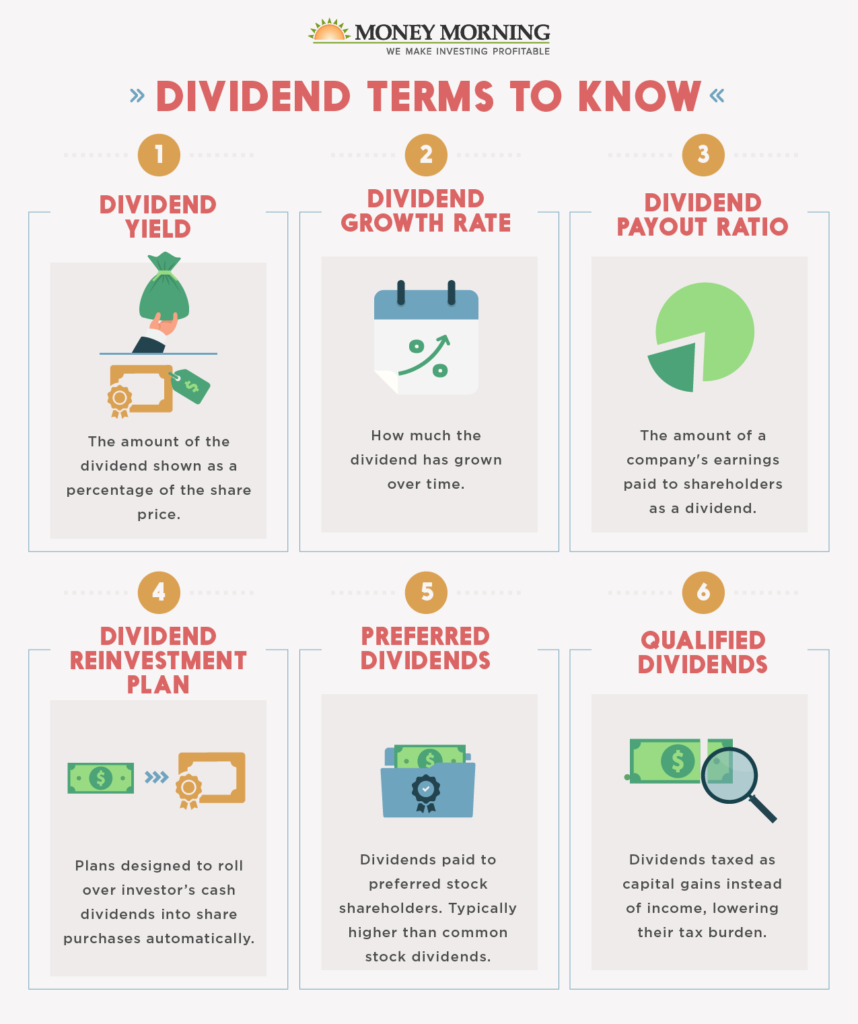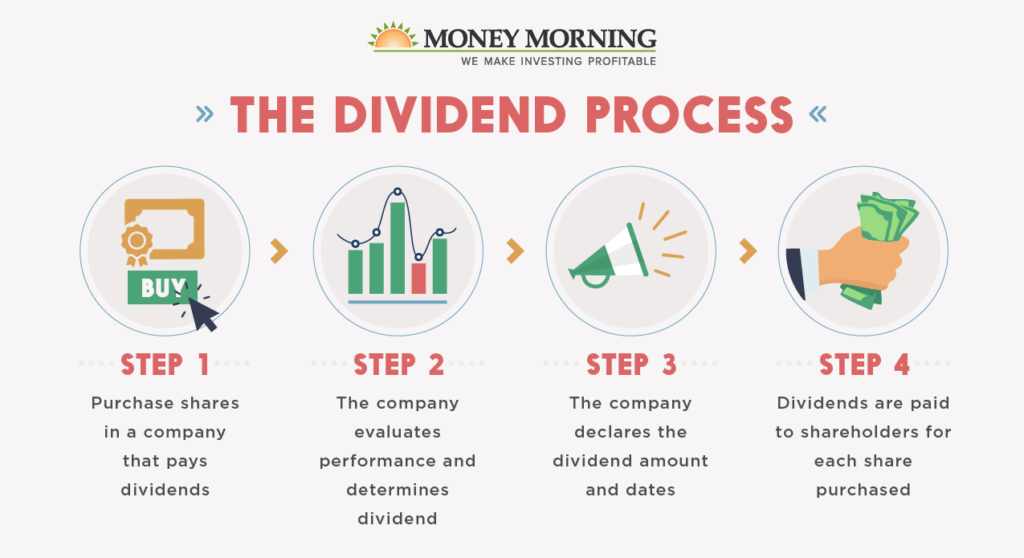Dividend investing is a way to make money by simply holding shares of a dividend yielding stock.
Companies that pay dividends give some of their earnings to shareholders. Even if the stock price doesn't increase significantly, dividend investing ensures that you'll get money for owning that stock.
Investors who successfully earn dividend income can collect 10% or more on their holdings, and with a substantial investment that can really add up without them doing anything but keeping the shares in their portfolio.
You can use this strategy successfully, too - with this complete guide to dividend growth investing.
What Are Dividends?
When a company earns a profit, they choose what to do with that profit. The company can 1) Reinvest the money back into the business to pay debts, expand operations, and the like. Or the company can 2) Pass that money along to the shareholders who own the company. The latter is what dividends are.

Dividends are simply payments that a company makes to its shareholders. There are two types of dividends:
- Regular dividends, which companies consistently pay to shareholders over time. These are often paid quarterly, but there are monthly dividend stocks that offer shareholders more frequent payouts to bolster a portfolio.
- Special dividends, which are single payments that companies issue after selling assets or experiencing a particularly successful quarter.
To collect dividends from a company, you must be a shareholder on record at a specific time.
How Do Dividends Work?

Typically, dividends are paid by publicly traded companies, after a board of directors meets to determine if a payment is warranted. The total amount of the payments compared to the company's net income is known as the dividend payout ratio.
Before starting dividend investing, know that a stock's dividend yield relates to the share price. So if the annual dividend paid per share is $1.00, and the share price is $20.00, the yield is 1/20 or 5%. If the share price goes up, the dividend payout will be a smaller percentage of the stock price, resulting in a lower dividend yield.
Good dividend stocks pay on a per-share basis. Here's a dividend example: If you own 10 shares of Company X and the company chooses to pay $15 per share each year, you will receive $150 at the end of the year.
Some companies offer preferred dividends, which are accrued only on the company's preferred stock. The yield is based on the price of the preferred stock (when purchased) and is not affected by a stock's rising or falling value. In some cases, after paying preferred dividends, companies issue dividends to common shareholders-if there is money left.
Additionally, dividends are taxed as either ordinary or qualified. Qualified dividends are taxed at the capital gains rate rather than as part of your income. Qualified dividends must meet the following strict IRS conditions to receive such a tax rate:
- Stocks must have been owned for 60 days if it is common stock or 90 days if it is preferred stock.
- The dividend must come from a company in the United States or a qualified foreign company.
Dividend investing can play a significant role in growing your savings. To further diversify your dividend investments, consider dividend ETFs.
What Are Dividend ETFs?
Dividend ETFs are exchange-traded funds that hold multiple companies known for paying high dividends, letting you invest in all of them at once.
High dividend ETFs follow a specific index and are passively managed. Stocks in the ETF are evaluated to include high-yield dividend companies as well as blue-chip stocks that come with less risk.
The best dividend ETFs hold companies that have a history of growing their dividends and have a healthy payout ratio, so they aren't likely to cut their dividends any time soon.
Is Dividend Investing Right for Me?
If you're considering investing in stocks that pay a monthly dividend, or those that pay quarterly, you can take comfort in the fact that it is largely a safe form of investing. Such recurring payments keep rolling in as long as the company can afford them-whether the price of the stock rises or falls. This can help hedge bets if the market is uncertain.
Dividend investing can help you compound more shares and grow your wealth. Many companies offer dividend growth reinvesting, which allows shareholders to reinvest their dividends to acquire more stock.
Your dividends are used to buy more shares, so you own more of the company and, in turn, get more dividends as your share ownership goes up.
In some cases, companies that pay dividends are not high-growth companies since they share a portion of their profits with investors rather than focusing on expansion. However, the reliable form of steady income offered by dividends-especially dividend growth stocks which gradually increase dividends as they grow-is worth the trade-off.
Dividend Investing ROI
Dividend investing is a powerful investing strategy in terms of returns.
In a study by RBC Global Research Management, dividend-yielding stocks consistently and significantly contributed to total returns, year after year. More specifically, dividend investors saw an average of 11.2% returns on their investments. This amount is higher than the market average.
Tips for Dividend Investing
Finding the highest-paying dividend stocks takes a bit of savvy. Fortunately, there are a few things to keep in mind that will help your dividend investing be successful:
Look for high yields
It seems obvious, but it's important to know the yield of the stock you're interested in. Compare the yield to those of other stocks in the same industry. If they're similar, it's a good sign. Low yields can limit your returns, but excessively high yields could signal trouble in the company.
Know the industry
This ties in with the previous tip, but it's best to invest in an industry with which you're familiar. Be sure that the industry has good overall health to maximize your returns over a long period of time.
Look for qualified stocks
You don't want to be paying too much of your returns back in taxes, so be sure to have some qualified stocks in your portfolio to help get a lower tax rate.
Research the dividend coverage ratio
The dividend coverage ratio clues you into the safety of your dividend investing. It measures how many times a company can afford to pay dividends to its shareholders. Companies with steady cash flows have a higher ratio and are more likely to pay dividends to shareholders.
Learn how much of the profits are spent on dividends
While you want the company to pay dividends, you do not want the company to spend too much of its profits doing so. A good rule of thumb is that companies that pay less than 60% of their profits on dividends are safe investments.
Key Takeaways
Now that you're ready to get started in the world of dividend investing, keep these key aspects of dividends fresh in your mind:
- Dividends are payments made from companies to shareholders, either frequently as regular dividends or as one-offs known as special dividends.
- Qualified dividends get tax breaks at the capital gains rate.
- Dividend ETFs allow investors to own shares in a variety of good dividend stocks.
- The ROI on dividend-paying stocks outperforms the S&P over the long haul, especially when dividends are reinvested.
- Look for high yields, a high dividend coverage ratio, and a company that spends less than 60% of its profits on dividends when investing.
Dividend investing can be an excellent way to shore up your savings and portfolio for the future. For more information on how to create a financially stable future, check out our income investing for retirement guide.


